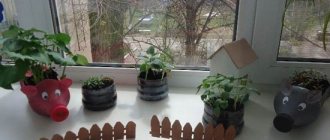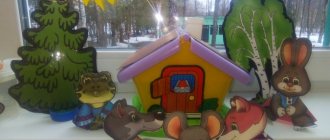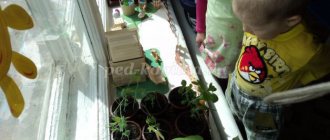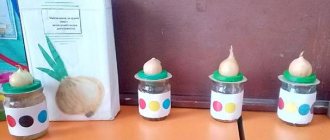Ecological project “Vegetable garden on the window” 2nd junior group
Environmental project on the topic
"Vegetable garden on the window"
in the second junior group
Author:
Lysak Tatyana Andreevna
MKDOU Chulym kindergarten "Topolek"
With. Chulym 2021
Description of material:
I bring to your attention an environmental project on the topic “Vegetable garden on the window” for the second junior group.
This material will be useful to teachers of the second junior group.
Project type:
informative.
Type of project:
group, research, creative.
Project participants:
children of the second junior group, group teacher, parents.
Social significance of the project: involving children in the work of growing greenery on the windowsill together with an adult in the winter, developing determination, observation, and nurturing an interest in the world of plants. Target group:
preschool children, preschool teachers, parents.
Relevance of the project
: Many parents who have their own gardens (dachas) do not suspect that the green kingdom will begin to arouse the child’s enormous interest if adults teach them to observe the plant, to see in the green sprout a special living creature, whose life depends entirely on whether it receives care or not . Only with the help of adults can a preschooler understand that the life of a plant depends on the presence of heat, light and good soil, and learn to distinguish a healthy and strong plant from a weak, frail one that requires “treatment.” Having learned to understand the state of plants, the child will sympathize and care for them. Thus, the tasks of cognitive-research, social-personal, and aesthetic development of the child are solved. Young children love to act. They understand the world around them practically, and their actions by observing the results. Practical activity is the direct participation of children in caring for plants. Introduction to feasible work caring for plants is, first of all, the development of such qualities as responsibility for completing an assignment, for the result obtained, commitment, and determination. And these are very important qualities for a child’s education at school. However, the problem is that children of primary preschool age do not have sufficient understanding of plants, where they grow, the necessary conditions for their growth, and their interest in cognitive and research activities is not sufficiently developed. To satisfy children's curiosity and instill the first skills of activity and independent thinking, we have created conditions for children's search and research activities. Familiarization with the growth and development of plants can be done in the winter-spring period by growing various crops from seeds and bulbs in the kindergarten premises, using a vegetable garden on the window.
Objective of the project:
the formation of an ecological culture in children and parents, the creation of conditions for the cognitive development of children through design and research activities and the organization of artistic and productive creative activities.
Involving parents in joint research activities. Project objectives:
• To develop children's knowledge about the growth and needs of plants; • Develop the ability to observe and care for garden crops; • Develop curiosity, interest in research and experimentation; • Foster a caring and caring attitude towards plants; • Form partnerships between teachers, children and parents.
Main stages and directions for implementing the project goal:
Preparatory stage
Teacher's activities: • Conversations with children (identifying the level of knowledge about plants).
• Drawing up a work plan for the project. • Collection of material necessary for the implementation of the project. • Reading fiction (rhymes, proverbs, sayings, songs related to gardening and vegetables). • Organization of a subject-development environment on the topic of the project. • Production of didactic games and manuals. Children's activities: • Examination of illustrative material, models of vegetables on the topic of the project. Interaction with family. • Collecting the necessary material to create a vegetable garden. • Joint discussion of activities to implement the project. Practical work
Activities of the teacher: • Conversation with children of an educational nature.
• Organization of a subject-development environment on the topic. • Preparation of information for parent corners. Children's activities: • Planting seeds of tomatoes, lettuce, onions, dill in the ground. • Plant care - watering, loosening, thinning, picking tomatoes. • Completing tasks in independent observations. • Gaming, motor activity. • Participation in practical activities. • Modeling vegetables from plasticine. • Guessing riddles about vegetables and fruits. Joint activities of adults and children: • Teacher's stories, reading children's fiction. • Various types of visual activities by topic. • Watching films about plants. • Collecting seed collections. • Examination of didactic pictures and illustrations about vegetables. • Work in the garden. Summing up
Activities of the teacher: • Final conversation with children (analysis of the work done). • Project presentation. • Representation of experience. Children's activities: • Participation in the final conversation about the work done. • Participation in the presentation of the project “Vegetable garden on the window” Dissemination of experience: • Familiarization of MKDOU teachers with successfully completed work. • Design of albums and photo exhibitions for parents.
Project implementation activities
1. Conversations: • “What is a vegetable garden and what grows in it,” • “What is a “Garden on a Window,” • “What plants can be grown on a windowsill,” • “Seeds.”
2. Experimental activities: • “Structure of plants”, • “Growth and development of plants”, • “Water and sprout”, • “Sun and sprout”, • “Growing seeds”. 3. Practical activities: • Selection and sowing of seeds. • Watering, care and monitoring of vegetable crops. 4. Ecological classes on the topics: • “Seeds” • “First shoots” • “The world of vegetables”. 5. Game activities: • Didactic games: “Wonderful bag”, “Guess by taste”. • Board game “Paired Pictures”, “Vegetables”. • Looking at illustrations depicting various plants that can be grown on a windowsill. • Looking at different seeds. • The plot is a role-playing game “Vegetable shop”. 6. Artistic and creative activities of children. • Coloring pictures. • Drawing “Onions cure all ailments.” • Application “Tomatoes in a jar”. • Modeling “Vegetables large and small.” 7. Speech development. • Reading fairy tales: “Turnip”, “Tops and Roots”, “Puff”. • Dramatization - the game “Once upon a time a housewife came from the market.” • Children's story on the topic: “And in our garden.” • Learning poems, riddles, proverbs and sayings about vegetables with children. 8. Album design “Our bow cures all ailments.” 9. Consultation for parents “Helping a child in the garden.” Resource support.
1. A selection of methodological and fiction literature and illustrations.
2. Ecological corner. 3. Methodological tools: lesson notes, card index of didactic games, etc. 4. Technical means: laptop, tape recorder, camera, etc. Estimated distribution of roles in the project group
Educator: selects the necessary material, organizes educational situations (planting crops), effectively develops the creative and cognitive thinking of preschool children, and attracts parents of pupils to replenish the developmental environment of the group and the knowledge of preschoolers. Children: participate in educational activities, observe the germination of garden crops. Parents: purchased land, seeds, material for planting care, organized a development environment for effective placement in the group. Risks: Illness of children, teachers, lack of material resources and other unforeseen circumstances.
Stages of project implementation 1) Preparatory
(February) 1. Determination of the goals and objectives of the project.
2.Analysis of existing conditions in a group, kindergarten. 3. Collecting information material about plants (riddles, sayings, poems) 4. Development of a comprehensive thematic work plan 5. Creating conditions for organizing work in the “window garden” 2) Main
(February, March, April) 1. Examination of seeds ( dill, lettuce, tomato) planting seeds and onions.
2. Research and practical activities of children to study the characteristics of growing cultural plantings: • soil preparation, purchasing seeds, planting, watering, loosening; • design of a vegetable garden on the window; • Observation of plants. 3. Reflection of the result through artistic and creative activity. 3) Final
(April) 1.Analysis of the results obtained. 2. Compiling a photo album “Our green garden!” 3. Presentation of the project “Vegetable garden on the window”.
Expected results:
You can grow a plant from a seed, bulb, or grain. By creating a garden on the window, we will grow onions, peas, tomatoes, cucumbers and other vegetables. Children will develop an interest in plants. They will be able to distinguish between certain types of plants, learn a lot of interesting things about the life of plants, and experimentally study the conditions necessary for their growth. Children will learn to make observations and make the first conclusions. Practical activity is the direct participation of children in caring for plants. Introduction to feasible work caring for plants is, first of all, the development of such qualities as responsibility for completing an assignment, for the result obtained, commitment, and determination.
Our project confirmed that in the future it is necessary to promote the merging of the child with the nature of his native land, to form an aesthetic attitude towards it, to deepen knowledge, improve skills, and support the individuality of each child. And then the child will show interest in research and cognitive activities, and will independently and creatively master new methods of research for a more accurate result. In the future, we plan to carry out this project in subsequent age groups, since during the project, children’s ideas about plants as living organisms, about the conditions necessary for growth and development have expanded, an aesthetic sense has developed, and the ability to enjoy the beauty of grown plants and the result of their work. Children learned to observe, began to treat the plant world more carefully, and interact correctly with plants according to the “do no harm” principle. All project participants (children, teachers, parents) received positive emotions from the results obtained.
Bibliography:
- Ivanova A.I. “Ecological observations and experiments in kindergarten. World of Plants", M.: 2005. 2. Komarova N.G., Gribova L.F. “The world in which I live”, M.: 2006. 3. Nikolaeva S.N. “Education of ecological culture in preschool childhood”, M. “Prosveshchenie”, 2005. 4. Poddubnaya L.B. “Nature around us”, M. “Corypheus”, 2006
5. Internet resources.





